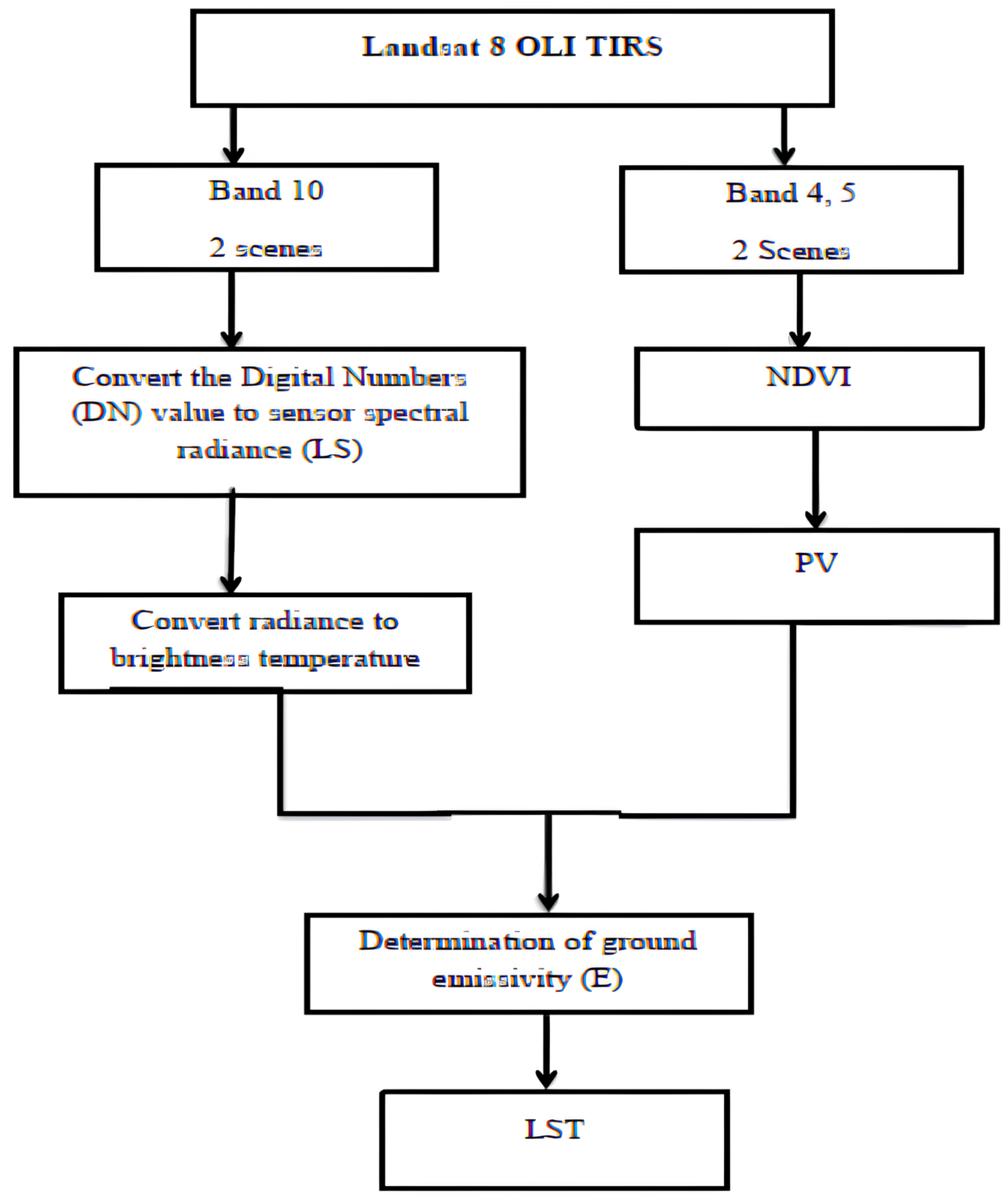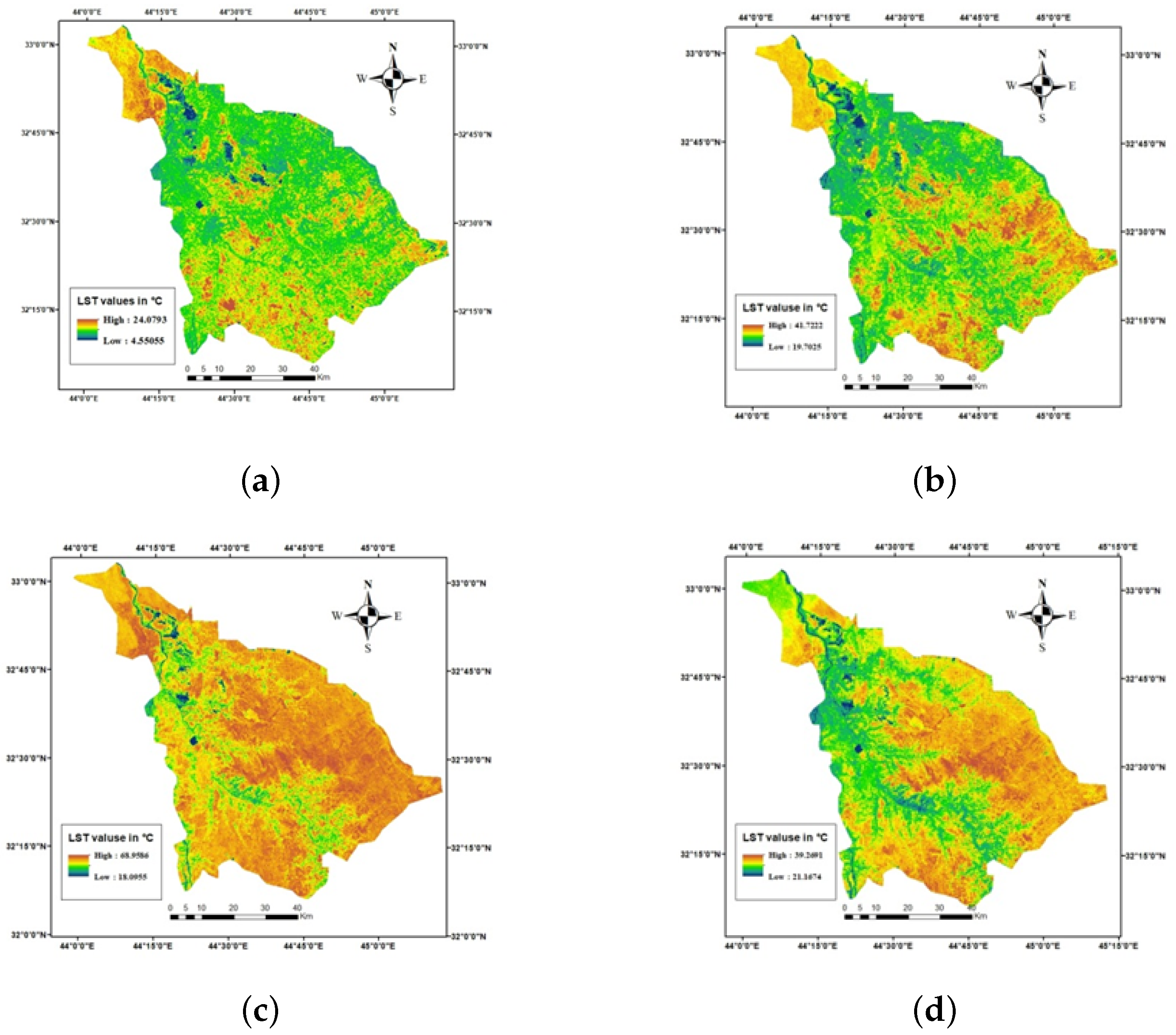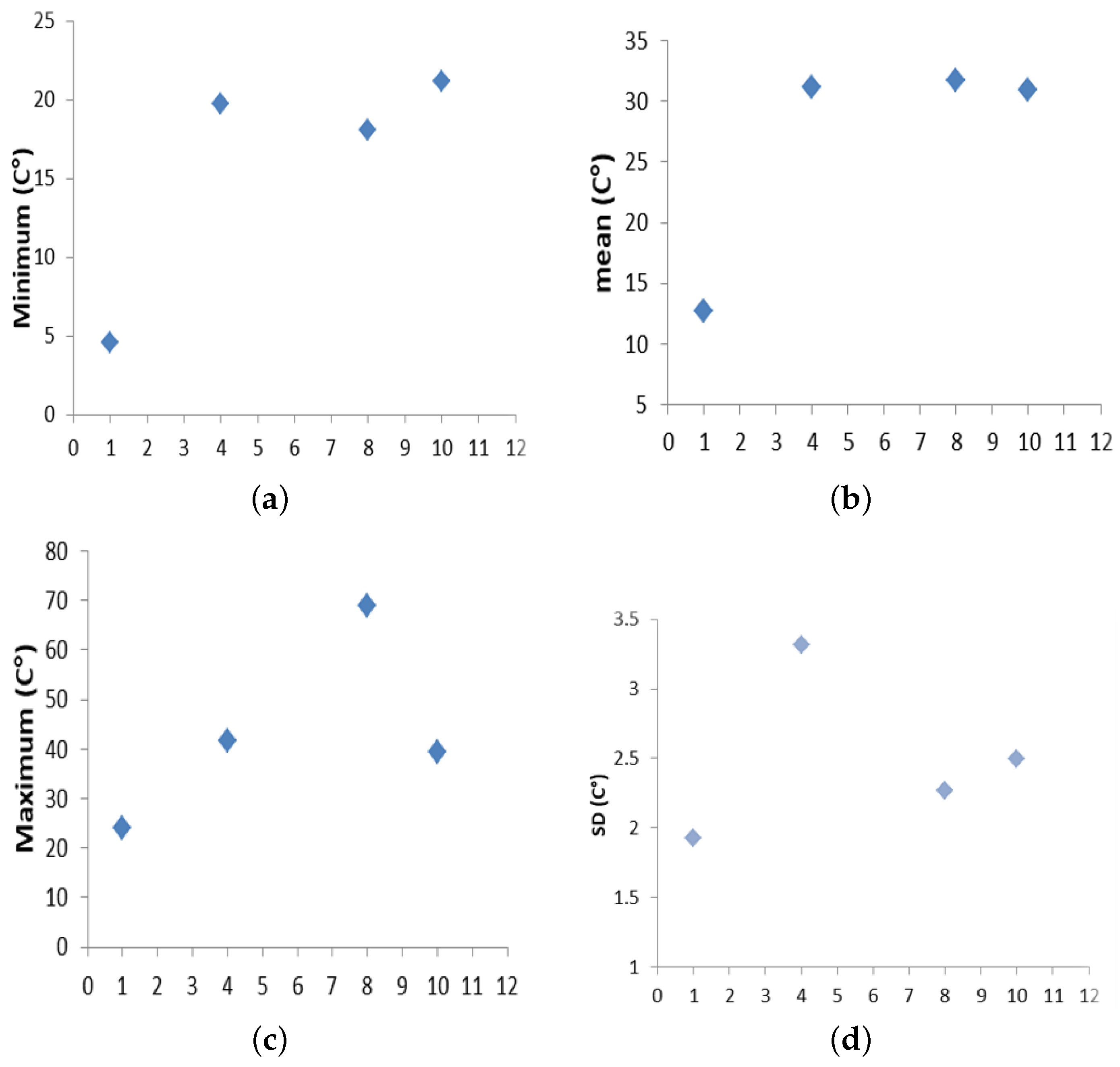Seasonal Variation in Land Surface Temperature in Babylon Governorate: A Remote Sensing and GIS Analysis †
Abstract
:1. Introduction
2. Methods
2.1. The Study Area
2.2. Dataset
3. LST Extraction from the Landsat Thermal Band
Data Reductions
4. Results
5. Discussion
6. Conclusions
Author Contributions
Funding
Institutional Review Board Statement
Informed Consent Statement
Data Availability Statement
Conflicts of Interest
References
- Shwetha, H.R.; Kumar, D.N. Prediction of high spatio-temporal resolution land surface temperature under cloudy conditions using microwave vegetation index and ANN. ISPRS J. Photogramm. Remote Sens. 2016, 117, 40–55. [Google Scholar] [CrossRef]
- Khandelwal, S.; Goyal, R.; Kaul, N.; Mathew, A. Assessment of land surface temperature variation due to change in elevation of area surrounding Jaipur, India. Egypt. J. Remote Sens. Space Sci. 2018, 21, 87–94. [Google Scholar] [CrossRef]
- Hazaymeh, K.; Hassan, Q.K. A remote sensing-based agricultural drought indicator and its implementation over a semi-arid region, Jordan. J. Arid. Land 2017, 9, 319–330. [Google Scholar] [CrossRef]
- French, A.N.; Inamdar, A. Land cover characterization for hydrological modelling using thermal infrared emissivities. Int. J. Remote Sens. 2010, 31, 3867–3883. [Google Scholar] [CrossRef]
- Li, H.; Zhou, Y.; Li, X.; Meng, L.; Wang, X.; Wu, S.; Sodoudi, S. A new method to quantify surface urban heat island intensity. Sci. Total Environ. 2018, 624, 262–272. [Google Scholar] [CrossRef] [PubMed]
- Weng, Q.; Fu, P.; Gao, F. Generating daily land surface temperature at Landsat resolution by fusing Landsat and MODIS data. Remote Sens. Environ. 2014, 145, 55–67. [Google Scholar] [CrossRef]
- Mahmoud, R.R.; Abood, R.H.; Kadhim, K.N. Studying the relationship between land cover lst utilizing Landsat 8 data in Karbala Governorate. Int. J. Civ. Eng. Technol. 2018, 9, 775–783. [Google Scholar]
- Artis, D.A.; Carnahan, W.H. Survey of emissivity variability in thermography of urban areas. Remote Sens. Environ. 1982, 12, 313–329. [Google Scholar] [CrossRef]
- Walawender, J.P.; Hajto, M.J.; Iwaniuk, P. A new ArcGIS toolset for automated mapping of land surface temperature with the use of LANDSAT satellite data. In Proceedings of the 2012 IEEE International Geoscience and Remote Sensing Symposium, Munich, Germany, 22–27 July 2012; IEEE: Piscataway, NJ, USA, 2012; pp. 4371–4374. [Google Scholar] [CrossRef]
- Kumar, D.; Shekhar, S. Statistical analysis of land surface temperature–vegetation indexes relationship through thermal remote sensing. Ecotoxicol. Environ. Saf. 2015, 121, 39–44. [Google Scholar] [CrossRef] [PubMed]
- Sobrino, J.A.; Jiménez-Muñoz, J.C.; Paolini, L. Land surface temperature retrieval from LANDSAT TM 5. Remote Sens. Environ. 2004, 90, 434–440. [Google Scholar] [CrossRef]
- Carlson, T.N.; Ripley, D.A. On the relation between NDVI, fractional vegetation cover, and leaf area index. Remote Sens. Environ. 1997, 62, 241–252. [Google Scholar] [CrossRef]
- Weng, Q.; Lu, D.; Schubring, J. Estimation of land surface temperature–vegetation abundance relationship for urban heat island studies. Remote Sens. Environ. 2004, 89, 467–483. [Google Scholar] [CrossRef]




| Season | Scene | Path/Row | Date | Scan Time | Sun Azimuth () | Sun Elevation () | Datum/UTM Zone |
|---|---|---|---|---|---|---|---|
| Winter | 1 | 168/37 | 2022-01-24 | 07:33:47.34 | 152.30 | 32.65 | WGS84/38 |
| 2 | 168/38 | 2022-01-24 | 07:34:11.23 | 151.56 | 33.80 | WGS84/38 | |
| Spring | 1 | 168/37 | 2022-04-30 | 07:33:23.79 | 129.13 | 63.60 | WGS84/38 |
| 2 | 168/38 | 2022-04-30 | 07:33:47.68 | 126.34 | 64.29 | WGS84/38 | |
| Summer | 1 | 168/37 | 2022-08-12 | 07:33:48.05 | 125.98 | 62.45 | WGS84/38 |
| 2 | 168/38 | 2022-08-12 | 07:34:11.95 | 123.26 | 63.07 | WGS84/38 | |
| Autumn | 1 | 168/37 | 2022-10-23 | 07:34:13.49 | 156.52 | 42.38 | WGS84/38 |
| 2 | 168/38 | 2022-10-23 | 07:34:37.38 | 155.61 | 43.59 | WGS84/38 |
| LST | Minimum | Maximum | Mean | Standard Deviation (SD) |
|---|---|---|---|---|
| Winter | 4.55054 | 24.07925 | 12.74871 | 1.92981 |
| Spring | 19.70248 | 41.72218 | 31.17165 | 3.31928 |
| Summer | 18.09548 | 68.95861 | 31.71405 | 2.26821 |
| Autumn | 21.16742 | 39.26906 | 30.97829 | 2.49600 |
Disclaimer/Publisher’s Note: The statements, opinions and data contained in all publications are solely those of the individual author(s) and contributor(s) and not of MDPI and/or the editor(s). MDPI and/or the editor(s) disclaim responsibility for any injury to people or property resulting from any ideas, methods, instructions or products referred to in the content. |
© 2024 by the authors. Licensee MDPI, Basel, Switzerland. This article is an open access article distributed under the terms and conditions of the Creative Commons Attribution (CC BY) license (https://creativecommons.org/licenses/by/4.0/).
Share and Cite
Hussain, M.M.K.; Al-Sadooni, A.A. Seasonal Variation in Land Surface Temperature in Babylon Governorate: A Remote Sensing and GIS Analysis. Eng. Proc. 2023, 59, 199. https://doi.org/10.3390/engproc2023059199
Hussain MMK, Al-Sadooni AA. Seasonal Variation in Land Surface Temperature in Babylon Governorate: A Remote Sensing and GIS Analysis. Engineering Proceedings. 2023; 59(1):199. https://doi.org/10.3390/engproc2023059199
Chicago/Turabian StyleHussain, Maysaa M. K., and Ameerah Ab. Al-Sadooni. 2023. "Seasonal Variation in Land Surface Temperature in Babylon Governorate: A Remote Sensing and GIS Analysis" Engineering Proceedings 59, no. 1: 199. https://doi.org/10.3390/engproc2023059199





